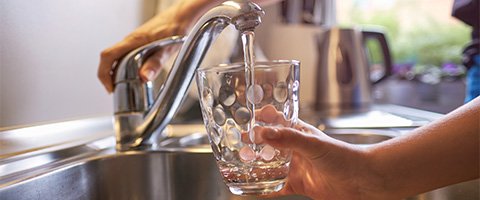Legionella bacteria are bacteria that can cause severe pneumonia (Legionellosis) or a flu-like illness (Pontiac fever). Under certain conditions, they can multiply in hot water systems. People can become infected when small water droplets form, for example, when inhaled while showering. An estimated 30,000 people contract Legionellosis each year, and about 50 to 100 times more contract Pontiac fever.
Occurrence of Legionella
The primary reservoir for Legionella is water. Its occurrence is significantly influenced by water temperature. Ideal conditions for Legionella proliferation exist at temperatures between 25°C and 50°C. They can also occur in cold water, but cannot proliferate to any significant extent there.
In water, Legionella bacteria multiply intracellularly in amoebae and other single-celled organisms (protozoa). Ideal conditions for Legionella bacteria to multiply are found on surfaces wetted or contaminated with water (e.g., water pipes and fittings, air conditioning systems). A complex, often inaccessible pipe network and "dead" branch lines—pipes with little or no flow—are breeding grounds for Legionella bacteria.
What can I do as a tenant?
Please ensure that the water flows regularly at all taps in your home. Ideally, this should be done three times a week. This will flush the water pipes and prevent stagnation, thus significantly reducing the risk of infestation. If a shower hasn't been used for a while, you should run hot water for a few minutes before showering for the first time, open the window, and avoid staying in the immediate shower area if possible due to the formation of aerosols.
Regularly cleaning and descaling shower heads, aerators, and flow regulators can also minimize the risk of Legionella. During extended absences (vacation, assembly work), tenants are required to let the hot and cold water run for a few minutes (see table below).
Handling drinking water after a long absence
Several factors can influence drinking water quality. This includes the material used to make the drinking water pipes. The quality can change, especially if the drinking water is left standing in pipes for extended periods. Homeowners and tenants are responsible for this. Therefore, you must ensure that the water in the pipes does not stagnate.
| Duration of user absence | Measures immediately before user absence | Measures immediately after user return |
|---|---|---|
| > 3 days | Apartments: Closing the floor barrier Single-family houses: Close the shut-off valve behind the water meter | Apartments: Open the floor lock; let the hot water run for about 5 minutes Single-family homes: Open the shut-off valve; let the hot water run for about 5 minutes |
| < 4 weeks* | Separate rarely used parts of the system: e.g., guest room, garage and basement connections | Regular, at least monthly, water renewal |
| < 4 weeks | Apartments: Close the floor valve Single-family houses: Close the shut-off valve | Apartments: Opening the floor tap and flushing the house installation Single-family houses: Open the shut-off valve and flush the house installation |
| > 6 months | Closing the main shut-off valve and emptying the pipes | Opening the main shut-off valve and intensively flushing the house installation |
| > 1 year | Disconnect the system or part of the system from the central drinking water supply or heating | Recommissioning only by a specialist and master craftsman |
* Regardless of these specifications, water hygienists recommend changing the water in a drinking water system three times a week If you encounter any problems – whether you cannot find your shut-off valves or they can no longer be closed – please contact Technical Customer Management or your caretaker. |
Instructions for installing a Legionella shower head with integrated filter
To install the Legionella shower head with integrated filter safely and easily, please follow these instructions: Materials required:
- New shower head,
- Adjustable wrench (optional),
- Pipe wrench with cloth (optional),
- Teflon tape (optional)
Step-by-step instructions:
1. Turn off the water
It's usually not necessary to turn off the main water supply. If the old shower head is dripping or leaking, it may be helpful to turn off the water before installing it.
2. Remove the old shower head, but please do not throw it away!
Unscrew the old shower head counterclockwise from the shower faucet. If it's difficult to remove, use a pipe wrench and a cloth to avoid damage.
3. Clean the thread
Remove any limescale or dirt deposits with a cloth or small brush. If necessary, wrap some Teflon tape around the threads for a better seal.
4. Install new shower head
Screw the new shower head clockwise onto the thread of the shower faucet. Tighten it by hand. If necessary, use pliers and a cloth for the final twist, but do not overtighten to avoid damage.
5. Functional test
Turn the water back on and check that the shower head is working properly and is leaking. If water is leaking from the thread, tighten the shower head slightly or use additional Teflon tape.
Contact person search
Für weitere Fragen oder Informationen
No matter what the issue: Caretaker, breakdown, repair or tenant issues.
Caretaker
Your first contact person for cleanliness, order and traffic safety around your apartment.
Mobile caretaker
Responsible for cleanliness, order and traffic safety in the neighborhoods and for compliance with the house rules in the evenings and at night.
Tenants' council
You should contact the tenants' council if you have questions about fundamental issues such as company policy, rent increases or modernisation of the entire housing stock.


